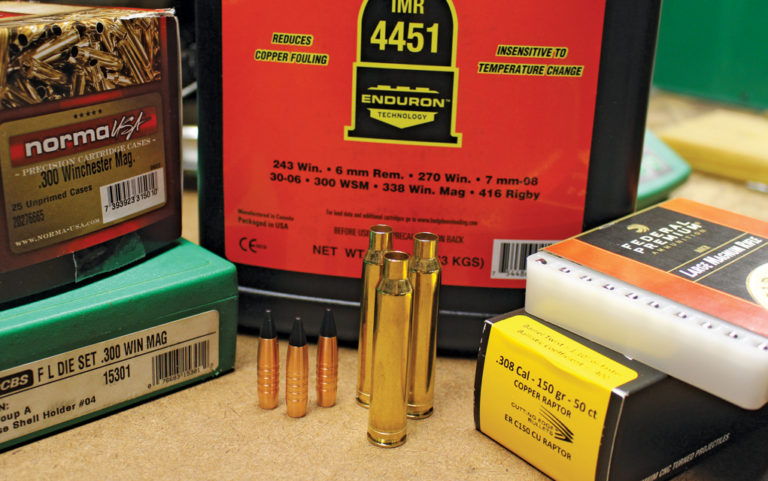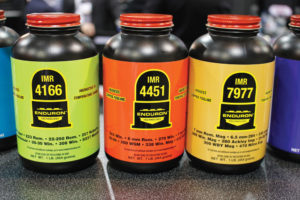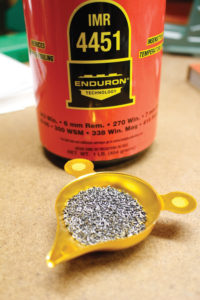

Advancements in propellants have reduced their sensitivity to temperature fluctuations. But heat and cold still play a role in how much pressure powders produce when ignited.
If you’ve ever examined some of the classic African safari cartridges, you may have noticed they seem to be rather large in comparison to their actual powder charges. The .416 Rigby, for example, has a huge case, while modern powders have trouble using all that capacity. The reason? Cordite, which was the common propellant at the time Rigby designed the case, was extremely sensitive to pressure fluctuations brought on by a change in temperature. In order to be effective in the tropical heat of India and Africa, Rigby over-designed the case size, to keep the pressures low in the extreme heat, for reliable extraction in a dangerous game situation.
Our modern powders—even those developed by the time the Second World War came around—have made a drastic improvement over cordite, but many will still show an increase or decrease in pressure, and thereby velocity, when the temperature goes up or down. The old rule was to expect an adjustment of 2 fps per degree Fahrenheit, up or down from an ambient temperature of 68˚F, and my experiences had pretty much proved that to be true.
Before heading to Africa for a safari, I used to leave my ammunition and rifle in the summer sun for hours, and then test it for pressure signs. Hodgdon had long ago released its Extreme Powder line, including a couple of favorites like VARGET and H4831SC, which have fueled many great handloads, but the new IMR Enduron Powder line has shown to be equally efficient.

This new powder series mimics many of the classic IMR powders we’ve all known and loved, but the Enduron line has been engineered to be especially insensitive to temperature fluctuations. There are four of them, with new number designations: IMR 4166, IMR 4451, IMR 4955, and IMR 7977.
The fastest burning of the four, IMR 4166, will give a burn rate in the range of VARGET and IMR 4064; perfect for the .308 and .30-06 Springfield, yet working very well in the .22-250 and .375 H&H. If you’ve got a caliber that is fueled by the medium-burn rate powders, like H380 or IMR 4320, the new IMR 4166 may solve any temperature issues you’ve experienced. I had great results in my Legendary Arms Works .308 Winchester with this powder and 180-grain Speer Grand Slam bullets; they have been equally accurate and consistent, whether observing group size at the range in the August heat or chasing black bears behind a pack of dogs in the frozen Maine woods in November.
The IMR 4451 is along the lines of good old IMR 4350; I used this in my .300 Winchester with 150-grain Cutting Edge Raptors for my last safari, and even the 112F South African heat posed no issue for this powder. Accuracy remained consistent, and there were no pressure problems whatsoever. This powder will work perfectly in the medium-magnums, if you will, like the .338 Winchester Magnum, the .300 Winchester Short Magnum, as well as the .30-06 and its brood of raucous children, whether the hunt takes place in Nunavut or Namibia.

IMR 4955 is designed to mimic the popular IMR 4831, and it is a very versatile powder in cases like the .270 Winchester and .25-06 Remington, as well as the 6.5-284 Norma. I’ve also used it in the larger safari cases like the .404 Jeffery and .450/400 3-in. Nitro Express. IMR 4955 pushes a 125-grain Peregrine PlainsMaster bullet from the muzzle of a 6.5-284 Norma at an even 2,950 fps, with a deviation of less than 12 fps, into three-shot groups measuring right around ¾ MOA; this makes for a perfect deer and pronghorn load, in any weather condition. If you shoot a cartridge that can utilize powders in the IMR 4831 burn rate, perhaps you should give IMR 4955 a try.
IMR 7977 has a burn rate perfect for the large, long-range magnum cartridges. The 7mm Remington Magnum, the .300 Remington Ultra Magnum, the .30-378 Weatherby and .338 Lapua all are well served by this slow-burning powder. 7977 is similar to, though definitely not interchangeable with, IMR 7828, which is also perfect for those large cases. Large quantities of slow-burning powders are the key to high velocity, and IMR 7977 fits the bill perfectly.
These huge-cased cartridges show their value with the slowest burn rates available, relying on a long barrel and huge powder column to develop the high pressures and correlative velocities. IMR 7977 is a powder that will not only feed these huge cases, but also keep the velocities and pressures even in a wide variety of weather conditions; you definitely don’t want to experience over pressures when the powder charges approach or exceed 100 grains, and I really like IMR 7977 for this application. It will also work in the WSM and WSSM series of cartridges, which have, at least in my experiences, been a rather finicky lot.

In addition to showing excellent tolerances for temperature changes—in a 100-degree swing, the variation is often less than 15 fps—the new Enduron line also meters very well through a powder thrower or automated dispenser. Being an extruded stick powder, cut to a grain length optimized for the modern powder throwers, the Enduron line will work almost as well as a ball powder in today’s machines. My RCBS ChargeMaster 1500 will throw consistent charges with all four of the Enduron powders; unlike those powders with longer grain structures, the grain length of the Enduron line will give consistent metering.
Will the Enduron powders replace the other classic IMR powders? I don’t think so; those have given us all some great results. But, I will say this: Whenever I have a hunt coming up in a distant location where the environment is less than optimal, I find myself reaching for one of the Enduron powders.
I can also say the same thing for when I’m testing a new bullet; the results I’ve found with this quartet have been so inspiring that I’ve made four new friends. If you’re looking for something new to try, whether it’s a new cartridge or a different bullet for an old friend, look to the Enduron line; I bet you’ll appreciate the results.
Editor's Note: This article is an excerpt from the December 2016 issue of Gun Digest the Magazine.

Next Step: Get your FREE Printable Target Pack
Enhance your shooting precision with our 62 MOA Targets, perfect for rifles and handguns. Crafted in collaboration with Storm Tactical for accuracy and versatility.
Subscribe to the Gun Digest email newsletter and get your downloadable target pack sent straight to your inbox. Stay updated with the latest firearms info in the industry.

![Best Concealed Carry Guns In 2025 [Field Tested] Wilson Combat EDC X9S 1](https://gundigest.com/wp-content/uploads/Wilson-Combat-EDC-X9S-1-324x160.jpg)


![Best 9mm Carbine: Affordable PCCs [Tested] Ruger Carbine Shooting](https://gundigest.com/wp-content/uploads/Ruger-Carbine-Shooting-100x70.jpg)
![Best AR-15: Top Options Available Today [Field Tested] Harrington and Richardson PSA XM177E2 feature](https://gundigest.com/wp-content/uploads/Harrington-and-Richardson-PSA-XM177E2-feature-100x70.jpg)

Having loaded 45+ years and the ADI temp-insensitive powders since they first came to the commercial market in early 1995, a person would be making a real blunder by not using the ADI powders for virtually any rifle application. Developing loads at 50-70F and having them still perform exceedingly well at zero or 100F is a huge factor in my using them exclusively.